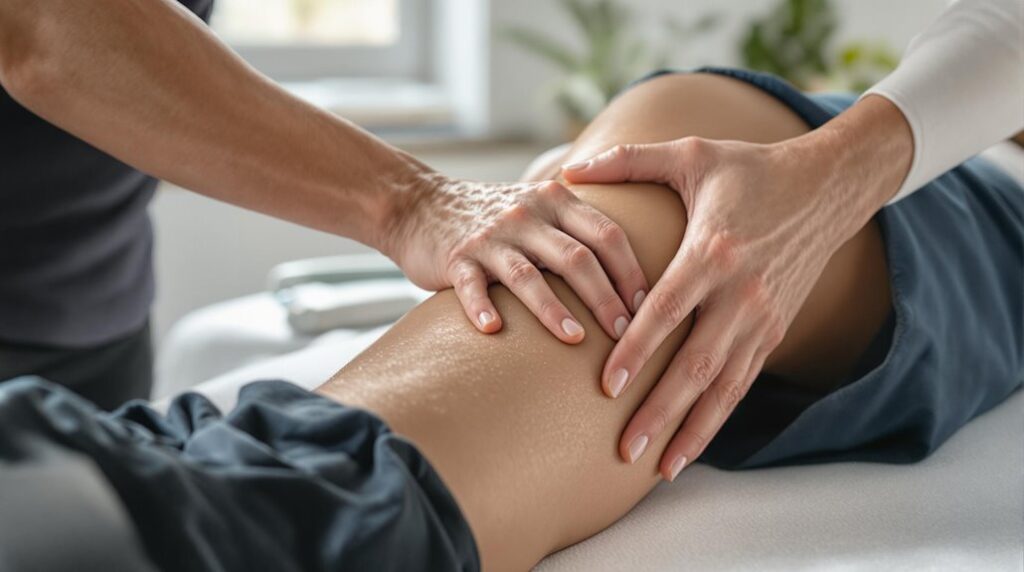Tissue mobilization techniques can greatly improve your athletic performance and recovery through targeted manipulation of soft tissues. You'll experience enhanced flexibility, reduced muscle tension, and improved range of motion while decreasing your risk of sports-related injuries. These techniques, including IASTM, foam rolling, and sports massage, promote better blood circulation and faster recovery between training sessions. The benefits extend beyond immediate relief, offering long-term advantages for your athletic development and performance potential.
Understanding Tissue Mobilization Techniques
While athletes have long relied on various recovery methods, tissue mobilization techniques have emerged as vital tools for enhancing performance and preventing injuries. You'll find several approaches to tissue mobilization, including instrument-assisted soft tissue mobilization (IASTM), foam rolling, and manual therapy techniques that target specific muscle groups and fascia.
These methods work by applying controlled pressure to your soft tissues, breaking up adhesions and scar tissue while increasing blood flow to the affected areas. When you're using these techniques, you're fundamentally reorganizing your body's connective tissues and promoting better range of motion. You'll notice that different tools and methods serve distinct purposes: IASTM tools provide precise pressure to specific areas, while foam rollers offer broader coverage for larger muscle groups. Additionally, sports massage has been shown to significantly improve recovery times and overall performance.
Enhanced Athletic Performance and Recovery
As athletes integrate regular tissue mobilization into their training routines, they often experience significant improvements in their performance metrics and recovery times. You'll notice enhanced flexibility and range of motion, which directly contributes to better athletic execution and decreased injury risk. When you combine tissue mobilization with your training program, you're setting yourself up for superior performance outcomes.
- Reduced muscle soreness and fatigue after intense workouts
- Improved blood circulation and nutrient delivery to muscle tissues
- Enhanced joint mobility and biomechanical efficiency
- Faster recovery between training sessions and competitions
Your body's ability to maintain peak performance levels will increase as tissue mobilization helps break down adhesions and scar tissue that can limit your movement patterns. This therapeutic approach supports both immediate performance gains and long-term athletic development. Additionally, tissue mobilization techniques, such as soft tissue therapy, can significantly enhance recovery processes by promoting relaxation and reducing muscle tension.
Injury Prevention and Risk Reduction
Through regular tissue mobilization, you'll greatly decrease your risk of sports-related injuries by addressing muscular imbalances and restrictions before they develop into serious problems. You can identify areas of tension and adhesions that might contribute to improper movement patterns, which often lead to strains, sprains, and overuse injuries.
When you maintain ideal tissue flexibility and mobility through regular mobilization techniques, you're creating a protective buffer against common athletic injuries. The process helps strengthen the connection between your muscles and fascia, improving your body's resilience to physical stress. You'll also benefit from enhanced proprioception, as tissue mobilization increases your awareness of joint position and movement, allowing you to better respond to changes in body position during athletic activities. Additionally, regular mobilization can aid in effective recovery strategies for managing existing injuries, ensuring you stay in top shape.
Improved Range of Motion and Flexibility
Regular tissue mobilization directly enhances your body's range of motion and flexibility capabilities, building upon its protective benefits against injury. Through targeted manipulation of soft tissues, you'll experience increased joint mobility and muscle extensibility, which translates to improved athletic performance.
- Your muscles and fascia become more pliable, allowing for greater extension and contraction during physical activities
- You'll notice reduced tension in chronically tight areas, particularly in your shoulders, hips, and lower back
- Your joints achieve ideal articulation as surrounding tissues become less restricted
- The enhanced tissue elasticity you gain leads to more efficient movement patterns
Pain Management and Muscle Tension Relief
When athletes integrate tissue mobilization into their training regimen, they'll experience significant relief from chronic pain and muscle tension that often accompanies intense physical activity. You'll notice how targeted pressure and manipulation techniques help break down adhesions and trigger points, which can be primary sources of discomfort during training and competition.
Through regular tissue mobilization sessions, you'll find that your muscles respond better to recovery, reducing the persistent soreness that can limit your athletic performance. The process works by stimulating blood flow to affected areas while releasing tension in the fascia and muscle fibers, effectively decreasing inflammation and pain signals. You'll also benefit from the technique's ability to target specific problem areas, allowing for a more focused approach to managing both acute and chronic pain conditions common in sports.
Long-term Benefits for Athletes and Active Individuals
Athletes who commit to long-term tissue mobilization practices can expect substantial improvements in their overall physical resilience and performance longevity. You'll find that consistent tissue work helps prevent chronic injuries while supporting your body's natural healing processes, leading to extended athletic careers and better training outcomes.
- You'll maintain ideal range of motion in your joints, which helps you perform complex movements more efficiently
- Your body will adapt better to increased training loads, reducing the risk of overuse injuries
- You'll experience enhanced muscle recovery between training sessions, allowing for more frequent high-intensity workouts
- Your neuromuscular coordination will improve, resulting in better movement patterns and reduced compensatory behaviors
When you incorporate regular tissue mobilization into your routine, you're investing in your body's long-term functionality and athletic potential.


